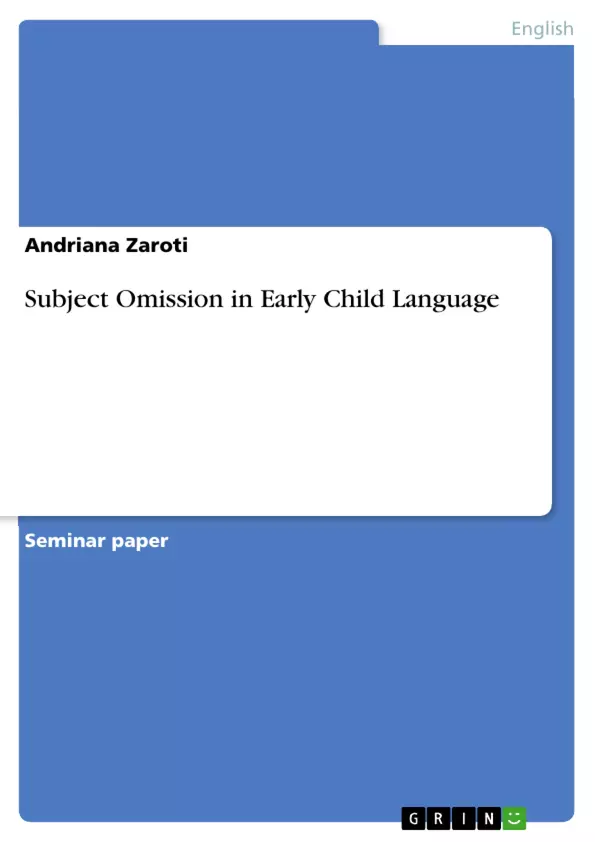The null-subject parameter or pro-drop parameter is one of the most discussed parameters in language acquisition. It is said that all children omit subjects until a certain age. Some studies claim that this happens due to the initial setting of the null-subject parameter. In this research paper different factors pertaining to the phenomenon of the so-called null-subject parameter will be discussed.
During the essay the majority of the focus will be will be placed on the discussion of that parameter. Therefore, different studies, which examine and try to explain the phenomenon of the null-subject parameter and the omission of subjects in early child language will be consulted, discussed and reflected upon. The main goal of the paper will be to answer the question whether the non-null-subject parameter is set from the beginning in the grammar of children who acquire English as a first language.
Firstly, a brief explanation of the Principles and Parameter Theory will be given and the null-subject parameter or pro-drop parameter and its importance in language acquisition will be explained. To facilitate the explanation of the said parameter some examples of sentences from non-null subject languages, such as English and null-subject languages, such as Italian, Greek and Spanish will be provided. Then, an overview of different approaches, studies and claims considering the null-subject parameter and the omission of subjects will be provided in order to outline the further processing of that essay.
Secondly, it will be moved on to the next part of the paper where two opposed studies, which try to explain why children omit subjects and if the reason for that omission is the null-subject parameter, will be presented and described. In order not to go beyond the scope of this paper, not all the available studies on that topic will be discussed.
In the next part of the paper, the selected studies’ findings will be stated and reflected. Furthermore, these studies will be compared to each other, to show possible differences and similarities regarding the different approaches. Based on that, their importance concerning the omission of subjects and the null-subject parameter will be outlined and discussed critically.
In the last part of the paper, the most important issues will be summarized and evaluated. Based on all findings of this paper and on the preceding discussion, a conclusion will be drawn in order to answer the research question.
Inhaltsverzeichnis (Table of Contents)
- 1.0 Introduction
- 2.0 State of Art
- 2.1 Principles and Parameters
- 2.2 The null-subject parameter
- 2.3 Studies on that field
- 3.0 Data
- 3.1 The pro-Hypothesis
- 3.2 The dual-value-solution
- 4.0 Discussion
- 5.0 Conclusion
Zielsetzung und Themenschwerpunkte (Objectives and Key Themes)
This research paper aims to investigate the phenomenon of subject omission in early child language acquisition, particularly focusing on the null-subject parameter and whether it is initially set in the grammar of children acquiring English as a first language.
- The null-subject parameter (pro-drop parameter) and its significance in language acquisition
- Comparative analysis of subject omission in null-subject languages (e.g., Italian, Greek, Spanish) and non-null-subject languages (e.g., English)
- Examination of different theoretical approaches and studies related to subject omission in early child language
- Critical discussion of the pro-hypothesis and the dual-value-solution in explaining subject omission
- Exploration of the potential impact of linguistic input on the setting of the null-subject parameter in child language acquisition
Zusammenfassung der Kapitel (Chapter Summaries)
- 1.0 Introduction: The introduction establishes the research question, outlining the focus on the null-subject parameter in English language acquisition. It provides a brief overview of the paper's structure and its main objectives.
- 2.0 State of Art: This section introduces the Principles and Parameters theory (Chomsky 1981) and its application to the null-subject parameter. It briefly explains the concepts of competence and performance and sets the stage for the discussion of studies related to subject omission in English child language.
- 2.1 Principles and Parameters: This part explains the principles and parameters framework, emphasizing the role of the null-subject parameter in determining subject omission in different languages. It highlights the innate nature of principles and the importance of parameter settings for language variation.
- 2.2 The null-subject parameter: This section delves into the null-subject parameter, discussing its two possible settings and the triggering mechanism through which children acquire the correct setting for their target language. It further clarifies the concept of parametric clusters and the potential restructuring of language based on parameter resetting.
- 2.3 Studies on that field: This section provides an overview of different studies and approaches related to subject omission, setting the context for the more in-depth discussion of specific studies in the following sections.
- 3.0 Data: This chapter focuses on the data and theoretical frameworks used to analyze subject omission in child language. It introduces two key hypotheses: the pro-hypothesis and the dual-value-solution, both of which aim to explain the phenomenon of subject omission in early language acquisition.
- 3.1 The pro-Hypothesis: This section explores the pro-hypothesis, outlining its claims and the mechanisms it proposes for explaining subject omission.
- 3.2 The dual-value-solution: This part delves into the dual-value-solution, presenting its alternative perspective on subject omission and contrasting it with the pro-hypothesis.
- 4.0 Discussion: This chapter analyzes and critically examines the findings of the studies presented in the previous sections, comparing and contrasting their different approaches. It aims to identify similarities and differences, highlighting the significance of these findings for understanding subject omission and the null-subject parameter.
Schlüsselwörter (Keywords)
The core themes and concepts explored in this research paper include the null-subject parameter, subject omission, early child language acquisition, principles and parameters theory, pro-hypothesis, dual-value-solution, null-subject languages, non-null-subject languages, and linguistic input. These keywords encompass the primary areas of investigation and provide a framework for understanding the central issues addressed in the paper.
- Citation du texte
- Andriana Zaroti (Auteur), 2014, Subject Omission in Early Child Language, Munich, GRIN Verlag, https://www.grin.com/document/276587



